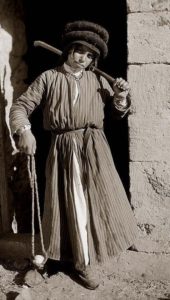Shepherds in Early Times

Abel: He is the first recorded shepherd. Cain was a farmer. Cain did not follow God’s advice in making an acceptable sacrificial offering to Him like Abel. Instead, Cain killed Abel because of envy.
Abraham: He became a farmer rancher and shepherd, starting off the shepherd culture of Israel.
Jacob: He accumulated a flock of sheep of his own.
David: He was the youngest son of Jesse. It was common practice that the youngest in the family become the shepherd. The older sons would help with the sowing, plowing, and harvesting. As they grew up, the shepherding job would be passed down to the younger sons. Drawing upon his experience as a shepherd, David knew he could defeat the Phillistine Goliath. David saw Goliath as the lion or bear that threatened his sheep.
Attitudes toward shepherds: Shepherds were often accused of having unfavorable reputations. The rabbis had contempt for the shepherds. Shepherds were not allowed to obtain a judicial position. Shepherds could not be used as witnesses. Shepherds were mostly identified with sinners, the poor, women, tax collectors, and outcasts.
Description of shepherds: They smelled like sheep. Shepherds did not have refined social skills. They were simple, regular guys. Shepherds would have been comfortable visiting the child Jesus. After first overcoming from their shock, these shepherds wouldn’t question the message from God. The shepherds would have said, “Did you see what I saw? “God said it—I believe it—That settles it.” They went straight to Bethlehem.
Occupation of the shepherds: The shepherds constantly kept watch and guarded their flocks against robbers and wolves. Sometimes it was necessary to travel long distances. Sometimes they had to remain in isolated areas for months. The shepherds would have taken turns on watch during the night.
What is a good shepherd? Shepherds had to guard against robbers stealing their sheep. The sheep would know their shepherd’s voice. The shepherd would summon his flock with his call. Strangers would try to copy the shepherd’s call.
What are the shepherds’ tools? The shepherds’ tools were a sling, staff, and rod.
Sling: This is David’s weapon of choice. The sling was a useful tool to head off a lagging or leading sheep back into the fold.
Staff: This is a long slender stick with a hook at one end. This stick was used for sheep handling and as a walking stick. The shepherd would have leaned on his staff for support and strength during long watches. This staff is also used to draw sheep together (bringing the newborn lamb to its mother, so that its mother will not reject her offspring.) This staff is also used to bring individual sheep back to the flock. This staff is also used to guide the sheep gently into new dangerous paths. This staff is also used to remove sheep stuck in bushes and thorns.
Rod: This is a throwing stick, curved and whittled down to fit the owner’s hands. This is the main weapon of choice of defense for himself and his sheep. The rod is a symbol of the shepherd’s power and authority. This rod is also used to discipline sheep. This rod is also used to correct wayward sheep from traveling in the wrong direction.
The shepherd throws the rod in order to turn the sheep the other way. This rod is also used to examine and count the sheep (pass under the rod). This rod is also used to protect the shepherd and his flock from bandits and wild animals. This rod is also used to examine the sheep for disease, wounds, and defects under the wool.
“Pulling the wool over one’s eyes”: On some occasions, deceitful shepherds would often use their rods to pull the sheep’s wool over its sores in order to hide them. These shepherds are attempting to “pull the wool over the other shepherd’s eyes in order to sell him his diseased sheep.
